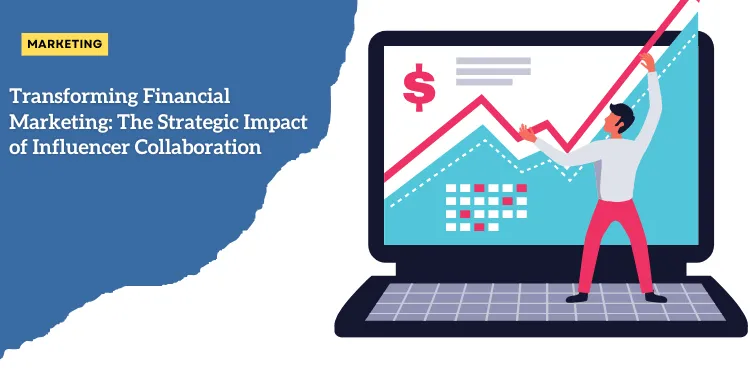Transforming Financial Marketing: The Strategic Impact of Influencer Collaboration

Anúncios
Traditional Financial Marketing Approaches and Their Limitations
For decades, the financial services industry relied on traditional marketing approaches.
These methods included print advertisements, television commercials, and direct mail campaigns.
Anúncios
Despite their widespread use, these conventional strategies often faced limitations.
They lacked personalization, leading to generic messages that sometimes failed to resonate with diverse audiences.
Additionally, tracking the effectiveness of these campaigns was challenging, making it difficult for financial brands to accurately measure their return on investment (ROI).
Anúncios
The Shift from Conventional Advertising to Influencer-Driven Strategies
Over the past ten years, there has been a significant shift in financial marketing strategies.
Financial services brands began to recognize the potential of digital channels and the influence of social media.
This led to a gradual move from traditional advertising to more dynamic, influencer-driven strategies.
Navigating Initial Hesitation Towards Influencer Marketing
At first, financial services brands were hesitant to embrace influencer marketing.
The idea of allowing influencers to interpret and convey brand messages was foreign and risky for a traditionally conservative industry.
This skepticism stemmed from several concerns:
-
🎯 Brand Control: Financial brands were wary of losing control over their messaging.
-
⚖️ Compliance Issues: Stricter regulatory requirements in the financial sector added complexity to working with influencers.
-
📋 Stakeholder Concerns: Internal stakeholders and legal teams needed convincing that influencer marketing could align with the brand’s values and objectives.
Despite these challenges, early adopters such as Virgin Money began to explore influencer collaborations by launching test campaigns and engaging in extensive internal discussions.
This strategic approach allowed them to address stakeholder concerns and navigate the legal landscape.
Overcoming Barriers and Achieving Success
Through careful planning and execution, financial services brands have successfully integrated influencer marketing into their overall strategy.
Key factors that contributed to overcoming initial hesitation include:
-
📚 Education and Training: Providing internal teams with comprehensive education about influencer marketing and its benefits.
-
📜 Clear Guidelines and Compliance: Establishing clear guidelines to ensure that influencer content complies with regulatory requirements.
-
🚀 Pilot Programs: Running pilot campaigns to gather insights and refine strategies before full-scale implementation.
By embracing these strategies, financial services brands have paved the way for more effective and engaging marketing efforts.
This transformation reflects the broader acceptance of influencer marketing across the industry.
As we explore further chapters, we will delve into how ‘finfluencers’ have reshaped the landscape of financial marketing, enhancing both credibility and reach.
Understanding the Rise of ‘Finfluencers’
Definition and Role of Financial Influencers in Modern Marketing
Financial influencers, often referred to as “finfluencers,” have emerged as key players in the modern marketing landscape.
These influencers are individuals with considerable expertise in financial matters who leverage their social media platforms to provide insights, advice, and recommendations on financial products and services.
Their role extends beyond merely endorsing products; they create informative and engaging content that resonates with their audience’s financial goals and values.
By sharing personal financial experiences, tips on budgeting, investing, and saving, finfluencers turn complex financial concepts into digestible and relatable information.
This approach builds trust and positions them as credible sources in a domain often perceived as intimidating or obscure.
Financial brands are recognizing the value of this authenticity and are increasingly collaborating with finfluencers to reach broader and more engaged audiences.
The Emergence of Lifestyle Creators in Financial Services Promotion
It’s not just traditional finfluencers driving this change.
Lifestyle creators, who typically focus on travel, wellness, fashion, and other everyday interests, are also making a mark in financial services promotion.
These creators infuse financial messages into their content, showing how financial products fit seamlessly into a balanced and liberated lifestyle.
For instance, a travel blogger might highlight how a particular credit card’s rewards program enhances their globetrotting adventures.
This subtle integration allows followers to see the practical benefits of financial products in real-life scenarios, making the information more relatable and appealing.
Why Finfluencers Have Become an Accepted Medium for Financial Brands
The integration of finfluencers and lifestyle creators into financial marketing strategies marks a significant shift for the industry.
Initially, financial services brands were hesitant to embrace this new wave of marketing due to concerns over compliance, brand image, and the loss of message control.
However, the success stories and measurable impacts have eased these reservations.
Brands are now adopting a “fish where your fish are” mentality, recognizing that consumers are more likely to engage with content on platforms they frequently use and trust.
The versatility and relatability of finfluencers have proven to be an effective way to connect with modern consumers who prioritize authenticity and peer recommendations over traditional advertising.
As companies like Virgin Money have shown, when executed thoughtfully, influencer marketing can enhance brand visibility, foster trust, and drive consumer action.
This acceptance indicates a broader industry trend towards more personal and relatable forms of marketing, aligning financial brands with the evolving preferences of their target audiences.
Strategic Implementation: The Virgin Money Case Study
Analysis of Virgin Money’s Test Campaign for M Plus Current Account
Virgin Money’s test campaign for the M Plus current account, launched in October 2022, marked a significant milestone in the brand’s marketing strategy.
This campaign was not a spur-of-the-moment decision but the result of extensive internal discussions and cautious planning.
Senior marketing manager Laura Davidson highlighted that collaborating with influencers for the first time required careful navigation through internal concerns within the procurement, legal, and finance teams.
Navigating Internal Stakeholder Concerns and Legal Considerations
The journey towards integrating influencers into Virgin Money’s marketing strategy involved addressing various stakeholder concerns.
Traditional stakeholders were unfamiliar with the concept of entrusting brand messaging to external creators, leading to initial reluctance.
The shift from creating standardized ads to empowering influencers to interpret and deliver messages required a change in mindset.
Virgin Money had to ensure that the campaign met legal and regulatory standards, maintaining control over content while allowing influencers the freedom to create authentic and engaging posts.
Extensive discussions with internal teams helped clarify these aspects, ensuring that the campaign complied with industry regulations and internal guidelines. By fostering a collaborative environment and educating stakeholders, Virgin Money could mitigate risks and build confidence in the influencer strategy.
Lessons Learned from Successful Influencer Integration
Virgin Money’s influencer campaign provided valuable insights for future initiatives.
One key takeaway was the importance of clear communication between the brand and influencers.
Establishing guidelines while giving creators the freedom to personalize their content ensured authentic and compelling messages.
This balance allowed influencers to connect with their audiences on a personal level, enhancing the campaign’s reach and impact.
Another lesson was the significance of choosing the right influencers who align with the brand’s values and target audience.
Virgin Money carefully selected financial influencers, or ‘finfluencers,’ who could effectively convey the benefits of the M Plus current account.
This strategic alignment built credibility and trust, critical components for success in financial services marketing.
By navigating internal resistance and legal complexities, Virgin Money demonstrated that a well-planned influencer strategy could yield significant benefits.
The positive outcomes from this campaign underscored the potential for influencer marketing to drive brand visibility, foster consumer trust, and differentiate the brand in a competitive market.
This successful implementation set the stage for more innovative and engaging marketing strategies in the financial sector, demonstrating the evolving nature of financial marketing.
As we continue to explore these trends, the emphasis will remain on authenticity, trust, and impactful brand-influencer partnerships.
Building Trust Through Authentic Partnerships
Creative Freedom in Message Interpretation
One of the critical components of building trust through influencer partnerships is allowing influencers the creative freedom to interpret brand messages authentically.
Unlike traditional advertisements where the messaging is tightly controlled, influencer marketing requires a more hands-off approach. Influencers, with their inherent connection to their audience, can craft messages that are more organic and relatable.
This creative liberty enables them to communicate the brand’s values and offerings in a manner that resonates personally with their followers.
Giving influencers creative freedom not only fosters authenticity but also harnesses their unique voices and storytelling styles, making the content more engaging.
This strategy acknowledges that influencers know their audience better than anyone else and can therefore adapt the brand message to fit seamlessly into their content.
The key is for financial brands to trust the influencers’ expertise and perspectives, allowing them to craft narratives that align with both the brand and their personal style.
Balancing Brand Control with Authenticity
While creative freedom is paramount, maintaining brand integrity is equally critical.
Financial brands need to provide clear guidelines and frameworks within which influencers can operate.
This balance ensures that the content remains both authentic and aligned with the brand’s values and regulatory requirements.
To achieve this balance, brands should:
-
📝 Develop comprehensive yet flexible content guidelines that describe the key messages, values, and compliance requirements.
-
💬 Establish open communication channels to discuss content ideas and revisions collaboratively.
-
🔍 Regularly review and provide feedback on influencer content to ensure it adheres to brand standards without stifling creativity.
This collaborative approach not only produces more authentic content but also builds a stronger partnership between the brand and the influencer. By working closely together, both parties can achieve their shared goals: delivering meaningful, compliant, and genuine content.
Co-Creation and Brand Credibility
Co-creation, the collaborative process of developing content, significantly boosts the credibility of financial brands.
When financial brands and influencers co-create content, it results in more personalized and relatable messaging.
This partnership leverages the influencer’s in-depth understanding of their followers and the brand’s expertise in finance, creating content that feels both informative and trustworthy.
The process of co-creation involves mutual respect and understanding. Influencers bring their creativity and authenticity, while brands provide the necessary knowledge and insights.
This collaborative effort results in content that not only promotes financial products but also educates and empowers audiences in making informed decisions.
Through co-creation, financial brands can strengthen their credibility by:
-
🔍 Demonstrating a commitment to transparency and authenticity in their marketing practices.
-
🤝 Building deeper relationships with audiences through content that feels personal and trustworthy.
-
🌟 Enhancing brand recognition by associating with influencers who are already trusted by their followers.
As brands continue to embrace influencer marketing, they must recognize that authenticity is the cornerstone of this strategy.
By allowing creative freedom, maintaining balanced control, and engaging in co-creation, financial brands can build strong, trusted partnerships that resonate with their audience and drive meaningful engagement.
Moving forward, the financial marketing landscape will undoubtedly continue to evolve.
The strategies and principles discussed here lay a solid foundation for adapting to future trends and innovations in this dynamic field.
Future Outlook: The Next Wave of Financial Marketing
Emerging Trends in Financial Services Influencer Marketing
The landscape of financial marketing will continue to evolve as influencers play an even more significant role.
Emerging trends indicate a deeper integration of technological advancements in influencer marketing:
- AI and Data Analytics: To maximize the impact of campaigns, financial brands will increasingly leverage AI and data analytics. These tools will help identify the most suitable influencers based on their audience demographics, engagement rates, and content style.
- Micro-Influencers: While prominent personalities have been the primary targets, there’s a growing emphasis on micro-influencers. Their smaller, yet highly engaged, follower base often results in higher conversion rates due to the more personal connection they maintain with their audience.
- Interactive Content: Expect a rise in interactive content, such as live Q&A sessions, webinars, and personalized financial planning tools via social media platforms. This trend aligns with the audience’s desire for immediate, personalized interactions.
Predicted Evolution of Brand-Influencer Relationships
The dynamics between financial brands and influencers are set to transform in several key ways:
-
🔗 Long-Term Partnerships: Rather than one-off campaigns, brands will forge long-term relationships with influencers. This strategy fosters deeper trust, enabling influencers to authentically integrate brand messages into their ongoing content.
-
⚖️ Stricter Compliance: With the evolving regulatory landscape, both brands and influencers will need to maintain rigorous adherence to compliance standards. Transparency in sponsored content and clear disclaimers will become non-negotiable.
-
🤝 Co-Creation: The trend towards co-creation will become more pronounced. Influencers will be involved in the campaign development process, allowing them to craft messages that resonate authentically with their followers.
Strategic Considerations for Future Financial Marketing Campaigns
To successfully navigate the future of financial marketing, brands should focus on several strategic considerations:
- Audience Insight: Deep understanding of audience behaviors, preferences, and pain points remains crucial. Tailoring content to these insights ensures relevance and engagement.
- Legal and Compliance: Continuous collaboration with legal teams to navigate the complex regulatory environment is essential. Clear guidelines will help maintain compliance without stifling creativity.
- Performance Metrics: Brands must develop robust metrics to evaluate the effectiveness of influencer campaigns. These should go beyond superficial engagement statistics, focusing instead on ROI, brand perception, and long-term customer relationships.
By embracing these strategies, financial brands can harness the evolving dynamics of influencer marketing for sustained growth and meaningful engagement.






